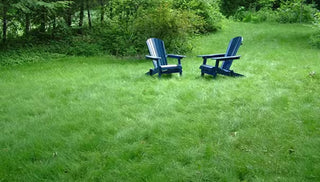Tired of spending summer weekends with a noisy lawn mower? Here's an alternative: the slow-grow lawn. With a small investment, you can convert your existing turf into fine fescue. These grasses are green and lush, but naturally slow-growing, so you mow only four to five times a year. And if you don't mind a slightly shaggy look—many find it attractive—you only need to fire up the mower one or two times each season. Another benefit of a slow-grow lawn: You can interplant with small, spring-blooming bulbs that will bloom, grow and mature before the lawn is ready for its first cut.
Fine fescues are a group of grasses that include:
- hard fescue (Festuca ovina spp. duriuscula)
- chewings fescue (Festuca rubra spp. rubra)
- creeping red fescue (Festuca rubra spp. rubra).
These grasses are often part of seed mixes for shady lawns, although the fine fescues flourish in sunny locations, too. They thrive in a large part of the U.S.: from Washington, DC, in the south to the border regions of Canada and west through the central and upper Midwest, as well as the Pacific Northwest. As long as the soil is well-drained, these adaptable grasses are drought-tolerant and—if mixed with clover—require little or no fertilization. However, fine fescues will not tolerate poorly drained, persistently damp soil.
Buying No- Grass Seed
Don't skimp when shopping for seed. You can buy a pre-mixed blend or create your own. It's important to buy named fescue cultivars, such as Windward chewings fescue or Spartan II hard fescue, for example. These superior strains have better color, and are more robust and disease resistant. Your state Cooperative Extension service can advise you about fescues that resist locally prevalent turf diseases. Whenever possible, buy endophyte-enhanced seed because it has a natural resistance to pests and diseases. Above all, mix it up: Your final seed blend should contain equal parts hard fescue, chewings fescue and creeping red fescue—at least two strains of each. Calculate the amount of seed you need by measuring the square footage of the area to be planted. On the seed package, you will find coverage, but most fescues should be applied at 6 to 8 lbs. per 1,000 square feet.
Seed Sources
- Prairie Nursery P.O. Box 306 Westfield, WI 53964 1-800-476-9453
- Wildflower Farm 10195 Hwy 12 West, R.R.#2 Coldwater, ON L0K 1E0 Canada 1-866-476-9453
- Seed Super Store PO Box 812 Buffalo, NY 14225 1-716-531-8788
How to Convert Your Lawn
Start in midsummer by watering the lawn several times to encourage new growth and make the grass vulnerable. Then, use a lawn mower (with the blade set very low) or a string trimmer to scalp the grass down to the soil surface. The object of the scalping is to shock the grass and rob it of its strength. Another technique: Smother the lawn with black plastic or pieces of carpet, which can take four to six weeks.
The lawn is ready for replanting as soon as you finish scalping it or remove the plastic or carpet. Don't bother removing any dead turf; you can plant right through it and it will serve as a mulch to enhance the germination of the new grasses.
Starting with a Blank Canvas
If you're establishing a new lawn, the technique is different. The key is to remove all existing plants before spreading seed—just as you would when planting any type of grass seed.
5 Tips for Sowing Slow Growing Grass Seed
- The best time to plant the new seed is from late summer to early fall. The weather tends to be cool and relatively moist in most regions of the United States, and annual weeds, such as crabgrass, are less aggressive then.
- Till the soil and rake it smooth. Calculate the amount of seed you need and divide it in half.
- To ensure even coverage, spread the seed in a grid pattern. Start with the first half and spread it in rows—going in the same direction. Cover the entire area.
- Repeat the process with the second batch of seed, but walk in rows that are perpendicular to the first rows. Note: You can also rent a slit seeder, also known as an over-seeder. It looks similar to a lawn mower, but it cuts shallow grooves into the soil surface, sprinkling them with seed as it moves. This ensures good contact between the seed and soil, which is important for successful germination. It's relatively easy to use, especially if you splurge on a self-propelled model.
- After sowing, roll the soil surface with a soil roller to ensure good seed-soil contact. Cover the area lightly with straw and follow the watering routine described below.
Watering Your Low-Mow Lawn
For the first three weeks, water lightly in the morning and midafternoon—unless rainfall is abundant. This is essential to good germination. A battery-powered irrigation timer and high-rise sprinklers will make it easy.
Weed Control in a No-Mow Lawn
In spring, weed control is essential. Eradicate invading broadleaf weeds—such as dandelions and plantains—with spot treatments of a chelated-iron herbicide, which is a man-made version of a chemical compound that occurs naturally in the soil. When used according to the label, chelated iron poses little or no risk to wildlife and serves as fertilizer for the turf. Crabgrass may be more troublesome, but it can be forestalled. In early spring—when the forsythias bloom—apply a pre-emergent, low-toxicity crabgrass preventer. By early summer, the fine fescue turf will be weed- and pest-resistant. And you can spend your time playing or picnicking, rather than trudging behind a mower.
 By the time the lawn is ready for its first cut, these crocuses will have died back and the foliage will be mature.
By the time the lawn is ready for its first cut, these crocuses will have died back and the foliage will be mature.




